Landscape Spatiotemporal Heterogeneity Decreased the Resistance of Alpine Grassland to Soil Droughts
Abstract
:1. Introduction
2. Materials and Methods
2.1. Study Area
2.2. Data
2.2.1. Vegetation Index
2.2.2. Soil Moisture
2.2.3. Auxiliary Data
2.3. Methods
2.3.1. Soil Drought Resistance Evaluation
2.3.2. Spatial and Temporal Heterogeneity Indicators
2.3.3. Statistical Analysis
3. Results
3.1. Spatial Distribution of Soil Drought Thresholds
3.2. Changing Trends of Spatiotemporal Heterogeneity Indicators
3.3. Influences of Spatiotemporal Heterogeneity to Drought Resistance
4. Discussion
4.1. Landscape Heterogeneity Dynamics in Degradation-Restoration Progress
4.2. Impact of Landscape Heterogeneity on Soil Drought Thresholds
4.3. Implications and Uncertainties
5. Conclusions
Supplementary Materials
Author Contributions
Funding
Data Availability Statement
Conflicts of Interest
Abbreviations
| NDVI | Normalized Difference Vegetation Index |
| GEE | Google Earth Engine |
| MODIS | Moderate Resolution Imaging Spectroradiometer |
| SM | Soil moisture |
| SCV | Spatial variance |
| SAC | Spatial autocorrelation |
| TAC | Temporal autocorrelation |
References
- Bardgett, R.D.; Bullock, J.M.; Lavorel, S.; Manning, P.; Schaffner, U.; Ostle, N.; Chomel, M.; Durigan, G.; Fry, E.L.; Johnson, D. Combatting global grassland degradation. Nat. Rev. Earth Environ. 2021, 2, 720–735. [Google Scholar] [CrossRef]
- de Bello, F.; Lavorel, S.; Hallett, L.M.; Valencia, E.; Garnier, E.; Roscher, C.; Conti, L.; Galland, T.; Goberna, M.; Májeková, M.; et al. Functional trait effects on ecosystem stability: Assembling the jigsaw puzzle. Trends Ecol. Evol. 2021, 36, 822–836. [Google Scholar] [CrossRef] [PubMed]
- Yan, Z.; Gao, Z.; Sun, B.; Ding, X.; Gao, T.; Li, Y. Global degradation trends of grassland and their driving factors since 2000. Int. J. Digit. Earth 2023, 16, 1661–1684. [Google Scholar] [CrossRef]
- Gao, J.; Li, X. A knowledge-based approach to mapping degraded meadows on the Qinghai–Tibet Plateau, China. Int. J. Remote Sens. 2017, 38, 6147–6163. [Google Scholar] [CrossRef]
- Qian, D.; Li, Q.; Fan, B.; Lan, Y.; Cao, G. Characterization of the spatial distribution of plateau pika burrows along an alpine grassland degradation gradient on the Qinghai–Tibet Plateau. Ecol. Evol. 2021, 11, 14905–14915. [Google Scholar] [CrossRef]
- Kéfi, S.; Rietkerk, M.; Alados, C.L.; Pueyo, Y.; Papanastasis, V.P.; ElAich, A.; De Ruiter, P.C. Spatial vegetation patterns and imminent desertification in Mediterranean arid ecosystems. Nature 2007, 449, 213–217. [Google Scholar] [CrossRef]
- Li, C.; Jong, R.D.; Schmid, B.; Wulf, H.; Schaepman, M.E. Changes in grassland cover and in its spatial heterogeneity indicate degradation on the Qinghai-Tibetan Plateau. Ecol. Indic. 2020, 119, 106641. [Google Scholar] [CrossRef]
- Wang, Y.; Liu, H.; Zhao, W.; Jiang, J.; He, Z.; Yu, Y.; Guo, L.; Yetemen, O. Early warning signals of grassland ecosystem degradation: A case study from the northeast Qinghai-Tibetan Plateau. Catena 2024, 239, 107970. [Google Scholar] [CrossRef]
- Schwartz, N.B.; Budsock, A.M.; Uriarte, M. Fragmentation, forest structure, and topography modulate impacts of drought in a tropical forest landscape. Ecology 2019, 100, e02677. [Google Scholar] [CrossRef]
- Vicente-Serrano, S.M.; Quiring, S.M.; Peña-Gallardo, M.; Yuan, S.; Domínguez-Castro, F. A review of environmental droughts: Increased risk under global warming? Earth Sci. Rev. 2020, 201, 102953. [Google Scholar] [CrossRef]
- Piao, S.; Zhang, X.; Chen, A.; Liu, Q.; Lian, X.; Wang, X.; Peng, S.; Wu, X. The impacts of climate extremes on the terrestrial carbon cycle: A review. Sci. China Earth Sci. 2019, 62, 1551–1563. [Google Scholar] [CrossRef]
- Clark, J.S.; Iverson, L.; Woodall, C.W.; Allen, C.D.; Bell, D.M.; Bragg, D.C.; D’Amato, A.W.; Davis, F.W.; Hersh, M.H.; Ibanez, I.; et al. The impacts of increasing drought on forest dynamics, structure, and biodiversity in the United States. Glob. Change Biol. 2016, 22, 2329–2352. [Google Scholar] [CrossRef] [PubMed]
- Orimoloye, I.R.; Belle, J.A.; Ololade, O.O. Drought disaster monitoring using MODIS derived index for drought years: A space-based information for ecosystems and environmental conservation. J. Environ. Manag. 2021, 284, 112028. [Google Scholar] [CrossRef]
- Li, C.; Fu, B.; Wang, S.; Stringer, L.C.; Zhou, W.; Ren, Z.; Hu, M.; Zhang, Y.; Rodriguez-Caballero, E.; Weber, B. Climate-driven ecological thresholds in China’s drylands modulated by grazing. Nat. Sustain. 2023, 6, 1363–1372. [Google Scholar] [CrossRef]
- Fu, Z.; Ciais, P.; Wigneron, J.-P.; Gentine, P.; Feldman, A.F.; Makowski, D.; Viovy, N.; Kemanian, A.R.; Goll, D.S.; Stoy, P.C.; et al. Global critical soil moisture thresholds of plant water stress. Nat. Commun. 2024, 15, 4826. [Google Scholar] [CrossRef]
- Piao, Z.; Li, X.; Xu, H.; Wang, K.; Tang, S.; Kan, F.; Hong, S. Threshold of climate extremes that impact vegetation productivity over the Tibetan Plateau. Sci. China Earth Sci. 2024, 67, 1967–1977. [Google Scholar] [CrossRef]
- Zhang, Y.; Hong, S.; Liu, D.; Piao, S. Susceptibility of vegetation low-growth to climate extremes on Tibetan Plateau. Agric. Meteorol. 2023, 331, 109323. [Google Scholar] [CrossRef]
- Li, W.; Yan, D.; Weng, B.; Lai, Y.; Zhu, L.; Qin, T.; Dong, Z.; Bi, W. Nonlinear effects of surface soil moisture changes on vegetation greenness over the Tibetan plateau. Remote Sens. Environ. 2024, 302, 113971. [Google Scholar] [CrossRef]
- Xu, Y.; Dong, S.; Gao, X.; Yang, M.; Li, S.; Shen, H.; Xiao, J.; Han, Y.; Zhang, J.; Li, Y.; et al. Aboveground community composition and soil moisture play determining roles in restoring ecosystem multifunctionality of alpine steppe on Qinghai-Tibetan Plateau. Agric. Ecosyst. Environ. 2021, 305, 107163. [Google Scholar] [CrossRef]
- Pan, T.; Hou, S.; Liu, Y.; Tan, Q.; Liu, Y.; Gao, X. Influence of degradation on soil water availability in an alpine swamp meadow on the eastern edge of the Tibetan Plateau. Sci. Total Environ. 2020, 722, 137677. [Google Scholar] [CrossRef]
- Zhang, W.; Yi, S.; Qin, Y.; Sun, Y.; Shangguan, D.; Meng, B.; Li, M.; Zhang, J. Effects of Patchiness on Surface Soil Moisture of Alpine Meadow on the Northeastern Qinghai-Tibetan Plateau: Implications for Grassland Restoration. Remote Sens. 2020, 12, 4121. [Google Scholar] [CrossRef]
- Gómez-Fernández, D.; López, R.S.; Zabaleta-Santisteban, J.A.; Medina-Medina, A.J.; Goñas, M.; Silva-López, J.O.; Oliva-Cruz, M.; Rojas-Briceño, N.B. Landsat images and GIS techniques as key tools for historical analysis of landscape change and fragmentation. Ecol. Inform. 2024, 82, 102738. [Google Scholar] [CrossRef]
- Xie, Y.; Li, J.; Wulan, T.; Zheng, Y.; Shen, Z. Scale dependence of forest fragmentation and its climate sensitivity in a semi-arid mountain: Comparing Landsat, Sentinel and Google Earth data. Geogr. Sustain. 2024, 5, 200–210. [Google Scholar] [CrossRef]
- Ma, P.; Zhao, J.; Zhang, H.; Zhang, L.; Luo, T. Increased precipitation leads to earlier green-up and later senescence in Tibetan alpine grassland regardless of warming. Sci. Total Environ. 2023, 871, 162000. [Google Scholar] [CrossRef]
- Liu, C.; Li, W.; Zhu, G.; Zhou, H.; Yan, H.; Xue, P. Land Use/Land Cover Changes and Their Driving Factors in the Northeastern Tibetan Plateau Based on Geographical Detectors and Google Earth Engine: A Case Study in Gannan Prefecture. Remote Sens. 2020, 12, 3139. [Google Scholar] [CrossRef]
- Wang, Y.; Xiao, J.; Ma, Y.; Ding, J.; Chen, X.; Ding, Z.; Luo, Y. Persistent and enhanced carbon sequestration capacity of alpine grasslands on Earth’s Third Pole. Sci. Adv. 2023, 9, eade6875. [Google Scholar] [CrossRef]
- Liu, C.; Li, W.; Wang, W.; Zhou, H.; Liang, T.; Hou, F.; Xu, J.; Xue, P. Quantitative spatial analysis of vegetation dynamics and potential driving factors in a typical alpine region on the northeastern Tibetan Plateau using the Google Earth Engine. Catena 2021, 206, 105500. [Google Scholar] [CrossRef]
- Gu, Z.; Duan, X.; Shi, Y.; Li, Y.; Pan, X. Spatiotemporal variation in vegetation coverage and its response to climatic factors in the Red River Basin, China. Ecol. Indic. 2018, 93, 54–64. [Google Scholar] [CrossRef]
- Che, X.; Zhang, H.K.; Li, Z.B.; Wang, Y.; Sun, Q.; Luo, D.; Wang, H. Linearly interpolating missing values in time series helps little for land cover classification using recurrent or attention networks. ISPRS J. Photogramm. Remote Sens. 2024, 212, 73–95. [Google Scholar] [CrossRef]
- Zheng, C.; Jia, L.; Zhao, T. A 21-year dataset (2000–2020) of gap-free global daily surface soil moisture at 1-km grid resolution. Sci. Data 2023, 10, 139. [Google Scholar] [CrossRef]
- Zhou, J.; Zheng, Y.; Song, C.; Cheng, C.; Gao, P.; Shen, S.; Ye, S. Vegetation map of the Qinghai Tibet Plateau (2020); National Tibetan Plateau Data Center: Beijing, China, 2024. [Google Scholar]
- Ummenhofer, C.C.; Meehl, G.A. Extreme weather and climate events with ecological relevance: A review. Phil. Trans. R Soc. B 2017, 372, 20160135. [Google Scholar] [CrossRef] [PubMed]
- Li, X.; Piao, S.; Huntingford, C.; Peñuelas, J.; Yang, H.; Xu, H.; Chen, A.; Friedlingstein, P.; Keenan, T.F.; Sitch, S. Global variations in critical drought thresholds that impact vegetation. Natl. Sci. Rev. 2023, 10, nwad049. [Google Scholar] [CrossRef] [PubMed]
- Guo, W.; Huang, S.; Huang, Q.; Leng, G.; Mu, Z.; Han, Z.; Wei, X.; She, D.; Wang, H.; Wang, Z.; et al. Drought trigger thresholds for different levels of vegetation loss in China and their dynamics. Agric. Meteorol. 2023, 331, 109349. [Google Scholar] [CrossRef]
- Boulton, C.A.; Lenton, T.M.; Boers, N. Pronounced loss of Amazon rainforest resilience since the early 2000s. Nat. Clim. Chang 2022, 12, 271–278. [Google Scholar] [CrossRef]
- Andrade, B.O.; Koch, C.; Boldrini, I.I.; Vélez-Martin, E.; Hasenack, H.; Hermann, J.-M.; Kollmann, J.; Pillar, V.D.; Overbeck, G.E. Grassland degradation and restoration: A conceptual framework of stages and thresholds illustrated by southern Brazilian grasslands. Nat. Conserv. 2015, 13, 95–104. [Google Scholar] [CrossRef]
- Wang, Z.; Zhang, Y.; Yang, Y.; Zhou, W.; Gang, C.; Zhang, Y.; Li, J.; An, R.; Wang, K.; Odeh, I.; et al. Quantitative assess the driving forces on the grassland degradation in the Qinghai–Tibet Plateau, in China. Ecol. Inform. 2016, 33, 32–44. [Google Scholar] [CrossRef]
- Chen, J.; Yi, S.; Qin, Y. The contribution of plateau pika disturbance and erosion on patchy alpine grassland soil on the Qinghai-Tibetan Plateau: Implications for grassland restoration. Geoderma 2017, 297, 1–9. [Google Scholar] [CrossRef]
- Dakos, V.; Scheffer, M.; van Nes, E.H.; Brovkin, V.; Petoukhov, V.; Held, H. Slowing down as an early warning signal for abrupt climate change. Proc. Natl. Acad. Sci. USA 2008, 105, 14308–14312. [Google Scholar] [CrossRef]
- Hovick, T.J.; Elmore, R.D.; Fuhlendorf, S.D.; Engle, D.M.; Hamilton, R.G. Spatial heterogeneity increases diversity and stability in grassland bird communities. Ecol. Appl. 2015, 25, 662–672. [Google Scholar] [CrossRef]
- Wang, P.; Lassoie, J.P.; Morreale, S.J.; Dong, S. A critical review of socioeconomic and natural factors in ecological degradation on the Qinghai–Tibetan Plateau, China. Rangel. J. 2015, 37, 1–9. [Google Scholar] [CrossRef]
- Li, X.; Perry, G.L.W.; Brierley, G.; Sun, H.; Li, C.; Lu, G. Quantitative assessment of degradation classifications for degraded alpine meadows (heitutan), Sanjiangyuan, western China. Land Degrad. Dev. 2014, 25, 417–427. [Google Scholar] [CrossRef]
- Adams, S.N.; Jennings, S.; Warnock, N. Plant invasion depresses native species richness, but control of invasive species does little to restore it. Plant Ecol. Divers. 2020, 13, 257–266. [Google Scholar] [CrossRef]
- Vásquez-Méndez, R.; Ventura-Ramos, E.; Oleschko, K.; Hernández-Sandoval, L.; Parrot, J.-F.; Nearing, M.A. Soil erosion and runoff in different vegetation patches from semiarid Central Mexico. Catena 2010, 80, 162–169. [Google Scholar] [CrossRef]
- Pueyo, Y.; Moret-Fernández, D.; Saiz, H.; Bueno, C.G.; Alados, C.L. Relationships Between Plant Spatial Patterns, Water Infiltration Capacity, and Plant Community Composition in Semi-arid Mediterranean Ecosystems Along Stress Gradients. Ecosystems 2013, 16, 452–466. [Google Scholar] [CrossRef]
- Ríos, C.; Lezama, F.; Rama, G.; Baldi, G.; Baeza, S. Natural grassland remnants in dynamic agricultural landscapes: Identifying drivers of fragmentation. Perspect. Ecol. Conserv. 2022, 20, 205–215. [Google Scholar] [CrossRef]
- Wang, Y.a. Plant biodiversity and drought resilience: Insights from a resilience model study in North America. Ecol. Front. 2025, 45, 507–513. [Google Scholar] [CrossRef]
- Sun, M.; Li, X.; Xu, H.; Wang, K.; Anniwaer, N.; Hong, S. Drought thresholds that impact vegetation reveal the divergent responses of vegetation growth to drought across China. Glob. Chang. Biol. 2023, 30, e16998. [Google Scholar] [CrossRef]
- Wu, J.; Han, P.; Yu, J.; Jarvie, S.; Zhang, Y.; Zhang, Q. Edge grassland provide a stronger thermal buffer against core grassland in the agro-pastoral ecotone of Inner Mongolia. Ecol. Indic. 2023, 154, 110762. [Google Scholar] [CrossRef]
- Forte, T.a.G.W.; Carbognani, M.; Chiari, G.; Petraglia, A. Drought Timing Modulates Soil Moisture Thresholds for CO2 Fluxes and Vegetation Responses in an Experimental Alpine Grassland. Ecosystems 2023, 26, 1275–1289. [Google Scholar] [CrossRef]
- Abalori, T.A.; Cao, W.; Weobong, C.A.-A.; Li, W.; Wang, S.; Deng, X. Spatial Vegetation Patch Patterns and Their Relation to Environmental Factors in the Alpine Grasslands of the Qilian Mountains. Sustainability 2022, 14, 6738. [Google Scholar] [CrossRef]
- Hao, R.; Yu, D.; Liu, Y.; Liu, Y.; Qiao, J.; Wang, X.; Du, J. Impacts of changes in climate and landscape pattern on ecosystem services. Sci. Total Environ. 2017, 579, 718–728. [Google Scholar] [CrossRef] [PubMed]
- Xia, H.; Kong, W.; Zhou, G.; Sun, O.J. Impacts of landscape patterns on water-related ecosystem services under natural restoration in Liaohe River Reserve, China. Sci. Total Environ. 2021, 792, 148290. [Google Scholar] [CrossRef] [PubMed]
- Tello-García, E.; Huber, L.; Leitinger, G.; Peters, A.; Newesely, C.; Ringler, M.-E.; Tasser, E. Drought- and heat-induced shifts in vegetation composition impact biomass production and water use of alpine grasslands. Environ. Exp. Bot. 2020, 169, 103921. [Google Scholar] [CrossRef]
- Pan, Z.; Hu, Y.; Cao, B. Construction of smooth daily remote sensing time series data: A higher spatiotemporal resolution perspective. Open Geospat. Data Softw. Stand. 2017, 2, 25. [Google Scholar] [CrossRef]
- Wang, Y.; Du, Y.; Zhao, W.; Liu, H.; Jiang, J.; He, Z. Soil drought thresholds of alpine grassland deceased rapidly under the influence of extreme low temperature in northeastern Qinghai-Tibet Plateau. Ecol. Process. 2025, 14, 21. [Google Scholar] [CrossRef]

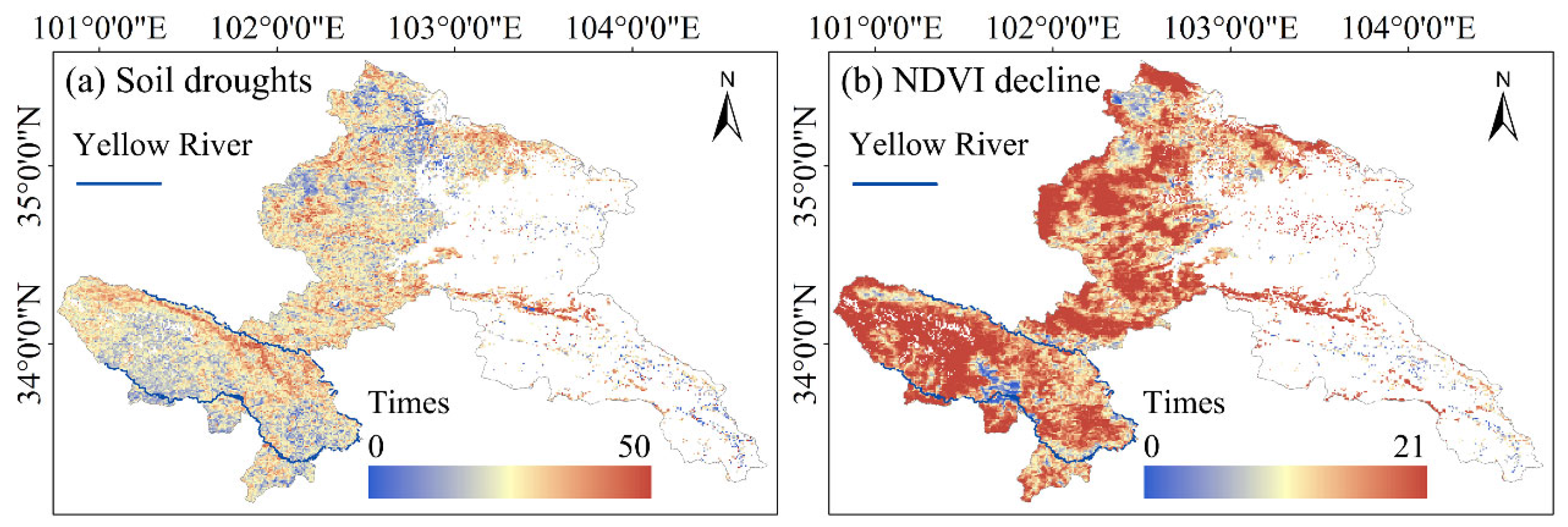
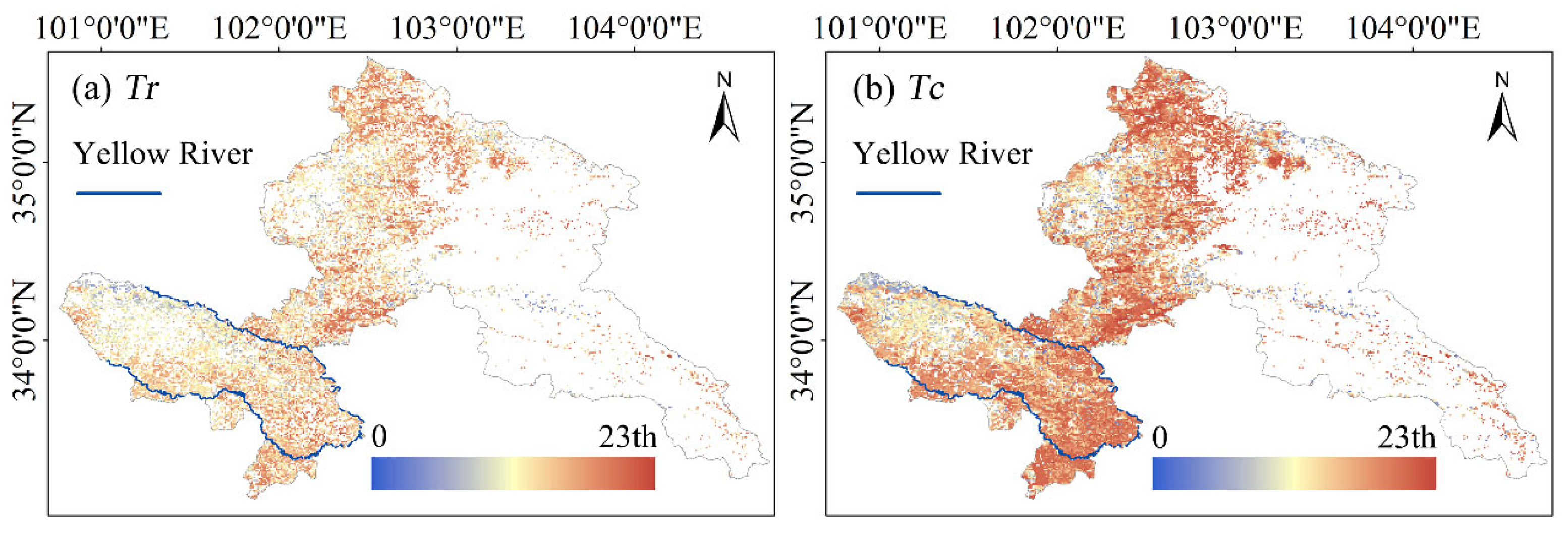

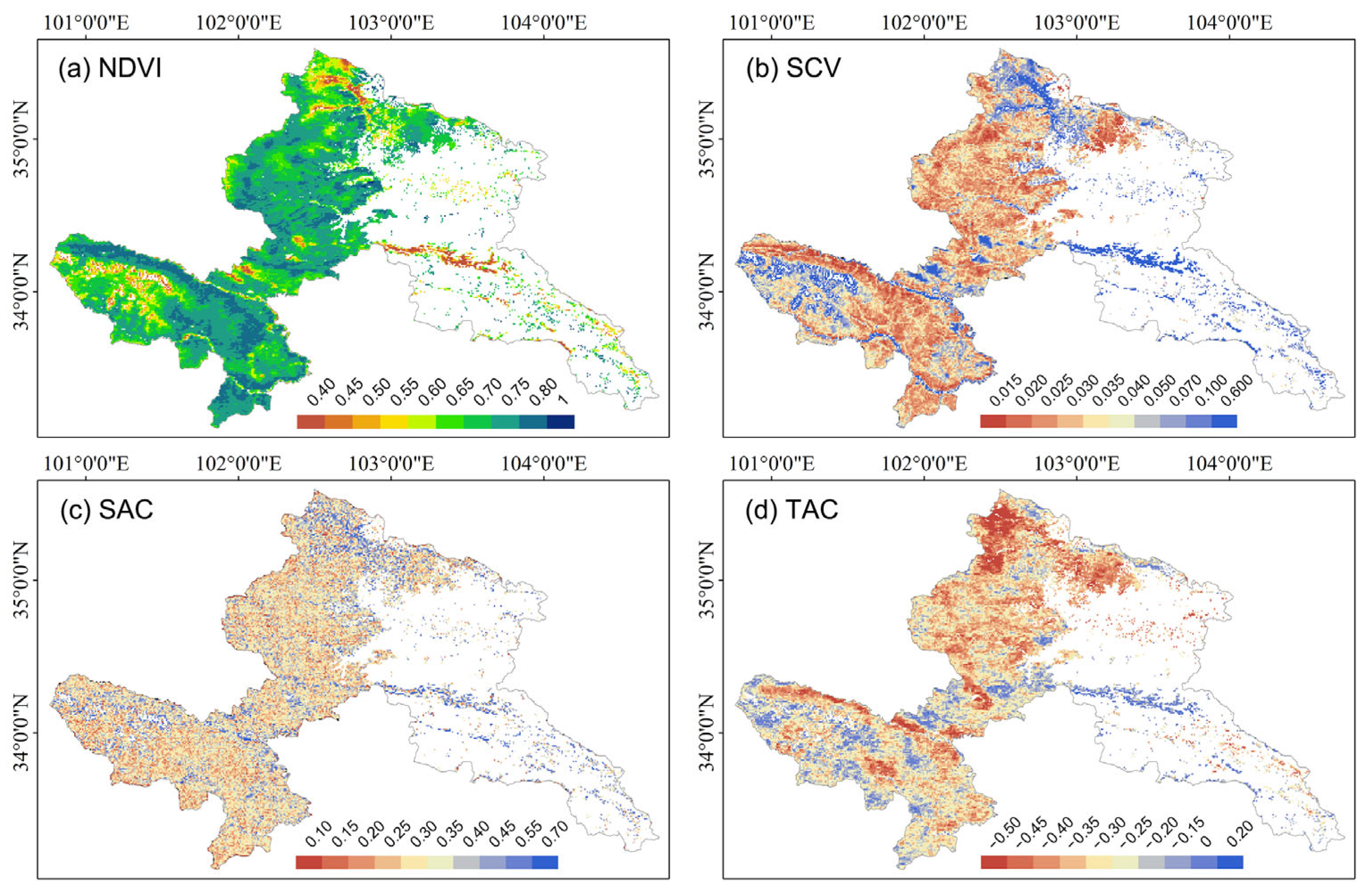
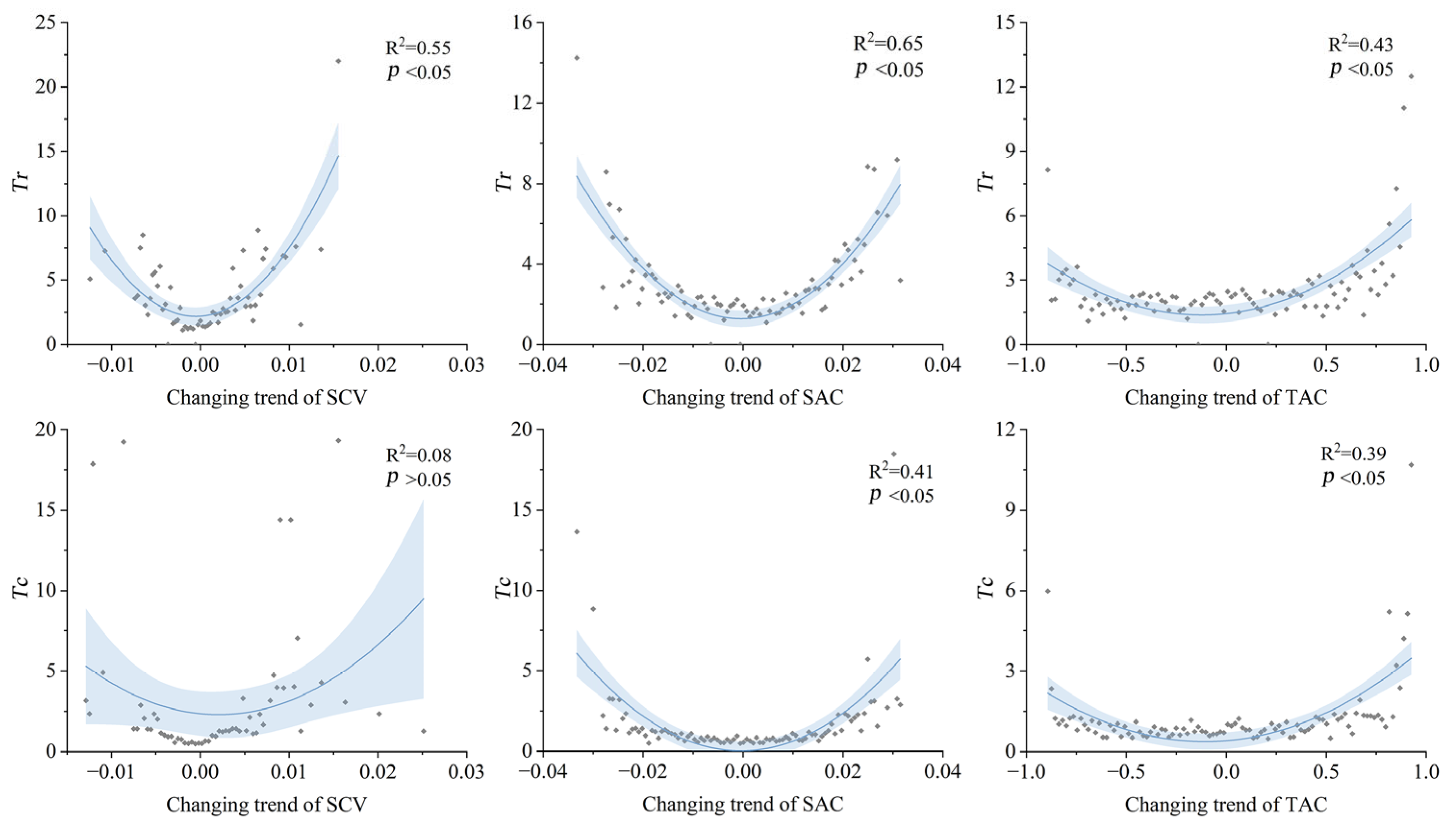
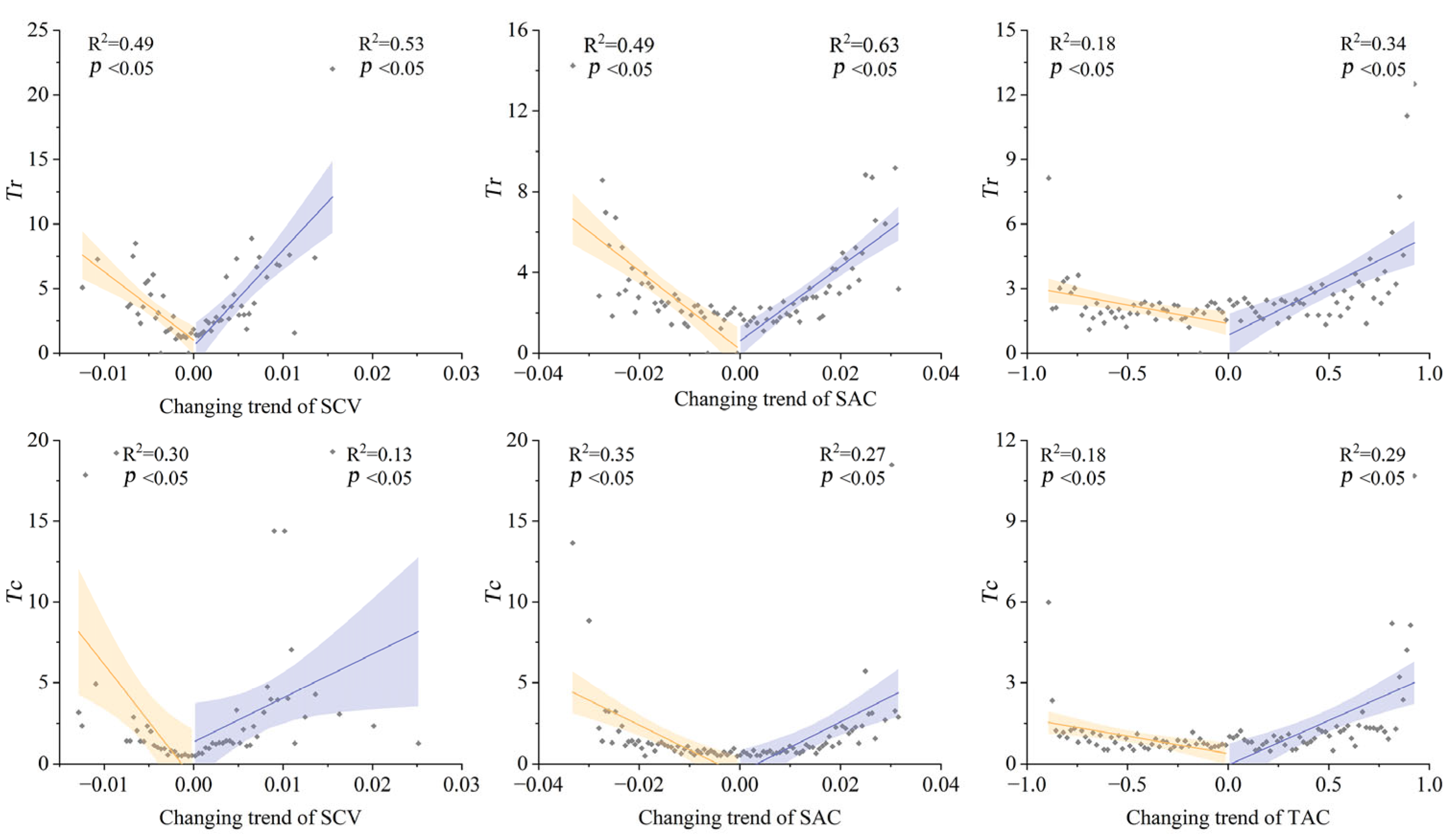
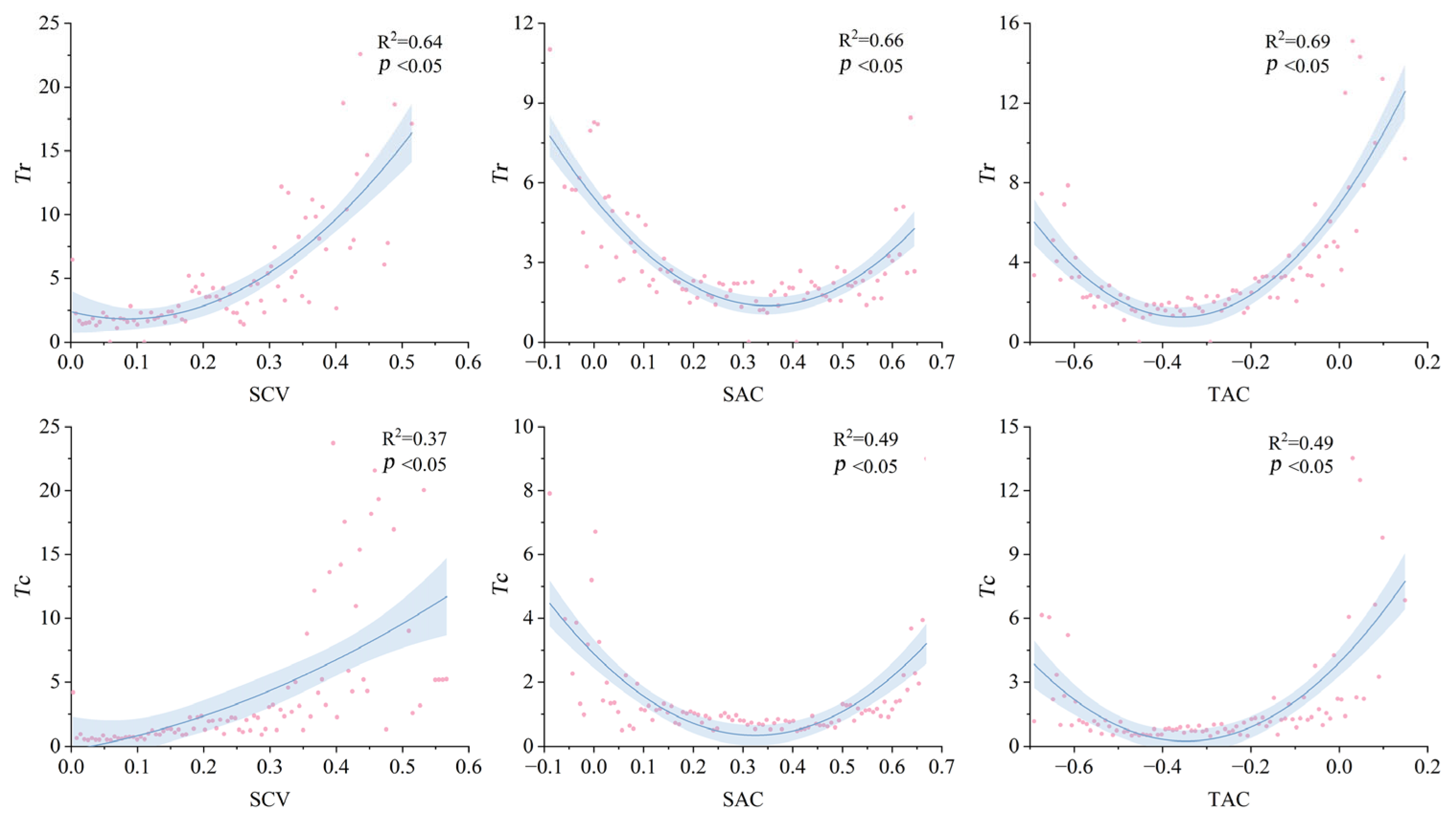
| Dataset | Spatial Resolution | Temporal Resolution | Source |
|---|---|---|---|
| MOD13A2 NDVI | 1 km | 16 days | MODIS (https://modis.gsfc.nasa.gov/, accessed on 3 April 2025) |
| MOD13Q1 NDVI | 250 m | 16 days | MODIS (https://modis.gsfc.nasa.gov/, accessed on 3 April 2025) |
| Soil moisture | 1 km | month | Global daily surface soil moisture dataset at 1-km resolution (2000–2020) (https://doi.org/10.11888/RemoteSen.tpdc.272760., accessed on 3 April 2025) |
| Land use | 30 m | - | GlobeLand30 V2020 (https://www.webmap.cn/, accessed on 3 April 2025) |
| Vegetation types | 1:500,000 | - | Vegetation map of the Qinghai Tibet Plateau (2020) (https://doi.org/10.11888/Terre.tpdc.300884., accessed on 3 April 2025) |
| NDVI | SCV | TAC | Percentage (%) |
|---|---|---|---|
| + | + | + | 14.11 |
| − | 19.49 | ||
| − | + | 20.91 | |
| − | 33.87 | ||
| − | + | + | 3.37 |
| − | 2.36 | ||
| − | + | 3.16 | |
| − | 2.73 |
Disclaimer/Publisher’s Note: The statements, opinions and data contained in all publications are solely those of the individual author(s) and contributor(s) and not of MDPI and/or the editor(s). MDPI and/or the editor(s) disclaim responsibility for any injury to people or property resulting from any ideas, methods, instructions or products referred to in the content. |
© 2025 by the authors. Licensee MDPI, Basel, Switzerland. This article is an open access article distributed under the terms and conditions of the Creative Commons Attribution (CC BY) license (https://creativecommons.org/licenses/by/4.0/).
Share and Cite
Wang, Y.; Liu, H.; Zhao, W.; Jiang, J.; He, Z. Landscape Spatiotemporal Heterogeneity Decreased the Resistance of Alpine Grassland to Soil Droughts. Remote Sens. 2025, 17, 1293. https://doi.org/10.3390/rs17071293
Wang Y, Liu H, Zhao W, Jiang J, He Z. Landscape Spatiotemporal Heterogeneity Decreased the Resistance of Alpine Grassland to Soil Droughts. Remote Sensing. 2025; 17(7):1293. https://doi.org/10.3390/rs17071293
Chicago/Turabian StyleWang, Yuxin, Hu Liu, Wenzhi Zhao, Jiachang Jiang, and Zhibin He. 2025. "Landscape Spatiotemporal Heterogeneity Decreased the Resistance of Alpine Grassland to Soil Droughts" Remote Sensing 17, no. 7: 1293. https://doi.org/10.3390/rs17071293
APA StyleWang, Y., Liu, H., Zhao, W., Jiang, J., & He, Z. (2025). Landscape Spatiotemporal Heterogeneity Decreased the Resistance of Alpine Grassland to Soil Droughts. Remote Sensing, 17(7), 1293. https://doi.org/10.3390/rs17071293








